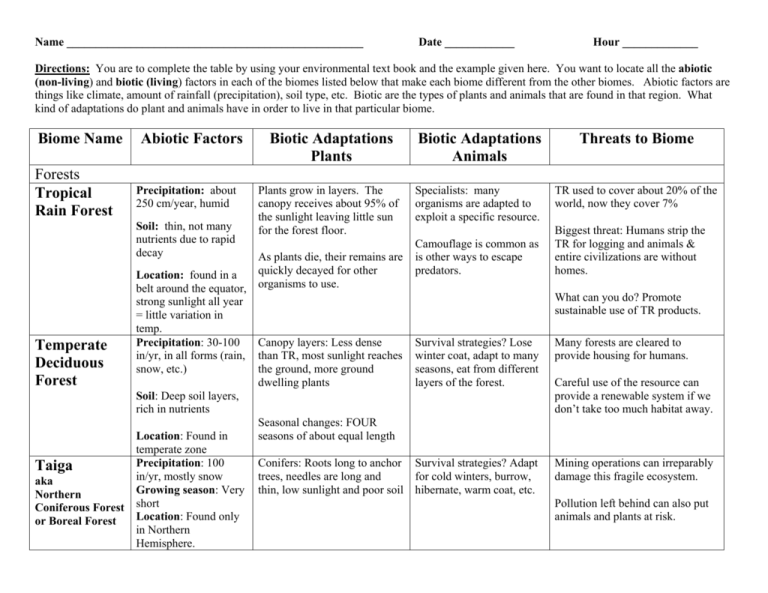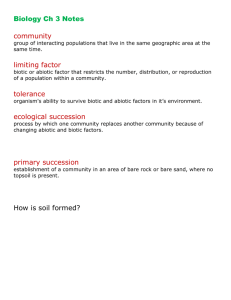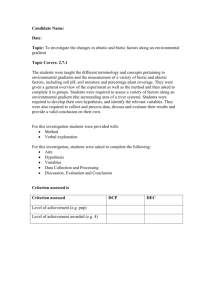Biome Name Abiotic Factors Biotic Adaptations Plants Biotic
advertisement

Name ___________________________________________________ Date ____________ Hour _____________ Directions: You are to complete the table by using your environmental text book and the example given here. You want to locate all the abiotic (non-living) and biotic (living) factors in each of the biomes listed below that make each biome different from the other biomes. Abiotic factors are things like climate, amount of rainfall (precipitation), soil type, etc. Biotic are the types of plants and animals that are found in that region. What kind of adaptations do plant and animals have in order to live in that particular biome. Biome Name Forests Tropical Rain Forest Abiotic Factors Precipitation: about 250 cm/year, humid Soil: thin, not many nutrients due to rapid decay Temperate Deciduous Forest Taiga aka Northern Coniferous Forest or Boreal Forest Biotic Adaptations Plants Biotic Adaptations Animals Threats to Biome Plants grow in layers. The canopy receives about 95% of the sunlight leaving little sun for the forest floor. Specialists: many organisms are adapted to exploit a specific resource. TR used to cover about 20% of the world, now they cover 7% As plants die, their remains are quickly decayed for other Location: found in a belt around the equator, organisms to use. strong sunlight all year = little variation in temp. Precipitation: 30-100 Canopy layers: Less dense in/yr, in all forms (rain, than TR, most sunlight reaches snow, etc.) the ground, more ground dwelling plants Soil: Deep soil layers, rich in nutrients Seasonal changes: FOUR seasons of about equal length Location: Found in temperate zone Precipitation: 100 Conifers: Roots long to anchor in/yr, mostly snow trees, needles are long and Growing season: Very thin, low sunlight and poor soil short Location: Found only in Northern Hemisphere. Camouflage is common as is other ways to escape predators. Biggest threat: Humans strip the TR for logging and animals & entire civilizations are without homes. What can you do? Promote sustainable use of TR products. Survival strategies? Lose winter coat, adapt to many seasons, eat from different layers of the forest. Many forests are cleared to provide housing for humans. Survival strategies? Adapt for cold winters, burrow, hibernate, warm coat, etc. Mining operations can irreparably damage this fragile ecosystem. Careful use of the resource can provide a renewable system if we don’t take too much habitat away. Pollution left behind can also put animals and plants at risk. Biome Name Abiotic Factors Biotic Adaptations Plants Grasslands, Chaparral, Deserts and Tundra Grows in Tufts Precipitation: 25-150 Tropical in/yr Resistance to Drought Grassland: Fire plays a large role Many plants have thorns and Savanna in this ecosystem Location: Found in tropics, near equator. sharp leaves to protect against predation. Contain the greatest number of grazing animals on Earth. Temperate Grasslands: Prairie and Steppe Chaparral Precipitation: less than Most abundant are plants 50 in/year precipitation called Bunch grasses, fine bladed grasses that grow in clumps to preserve water Mountains: Mountains often play a Sod-forming grasses that won’t role in climate dry out or blow away in wind. characteristics Location: Found in Russia and the Ukraine. Location: Primarily in coastal areas with Mediterranean climates. About 300 N and S of the equator. Climate: hot, dry summers, mild, wet winters. Slight variations in seasonal temperatures. Biotic Adaptations Animals Feeding strategy: Limited food leads to vertical feeding Reproduction: Reproduce during rainy season— ensures more young survive Adapt for short rainy season—migrate as necessary Many migrate, hibernate or burrow during extremes in temp and precipitation. Threats to Biome Invasive species Changes in fire management Because of their low elevation, some savannas are threatened by minor rises in sea level associated with global climate change Overgrazing…nomadic tribes have started to spend more time in one location. Infrastructure development (roads, buildings, etc). Unmanaged hunting and poaching is destroying herds of animals. Mostly low-lying shrubs and small trees. Many plants have leathery leaves to resist water loss. Camouflage: To avoid predation Food: Many animals will change their diet as the Many plant species have oils in season changes. leaves to help them resist fire…the fire will take out “weaker” plants that don’t belong. Human development—very desirable climate for humans to live. Biome Name Desert Tundra Abiotic Factors Biotic Factors Animals Precipitation: <10 in/year Soil: Little to no topsoil due to high winds. Minerals not deep in soil, Too dry for decay. Store water -Spines -Succulents -Thick, waxy cuticle -Shallow, broad roots Get water from food Thick outer coat, Burrow during day, Large ears Smaller animals-less surface area Precipitation: <25 in/year Growing close to the ground Small ears Climate: Temp rarely higher than 100C. Short growing season. Location: Found north of the Arctic Circle Having shallow roots to absorb the limited water resources. Insulation, thick coat Freshwater Ecosystems Littoral zone: nutrient Lakes rich area found close to and shore Ponds Biotic Factors Plants Threats to Biome Residential development Off road recreational activities destroy habitat for plants and animals. Some plants are removed by collectors, endangering the population. One of the most fragile biomes on the planet. The tundra is slow to recover from damage. Trees grow less than 1 m high! Oil drilling is proposed in Alaska and other areas. Plants are floating algae and plants along shoreline Animals live in or near water All water systems are being polluted and degraded by human impact Benthic zone: bottom of the lake where no sunlight can reach. Wetlands Marshes Uses for: Animal/plant homes, carbon “sink”, and water recharge areas, removing pollutants. Different types: Brackish and freshwater. Swamps/ Bogs Location: Found on flat, poorly drained land, often near streams Very shallow with land occasionally exposed Saturated soil Low oxygen in water and soil Emergent plants Large trees/shrubs Adapted to muddy soils Land soaked because of poor drainage Previous backfilling and clearing for farmland or development has been a concern. Decay is slow - Soil is acidic Biome Name Rivers Abiotic Factors At headwaters, usually cold and highly oxygenated. As it flows, it will broaden out, warm up and this completely changes the biota you’ll find. Biotic Adaptations Plants Will vary based on where in the river they are. Biotic Adaptations Animals At the headwaters, organisms need to hang on. Threats to Biome Industry uses water to dispose of waste products. Runoff from homes and other places causes changes in acidity, pollution, etc. Dams alter the flow of the water. Marine Ecosystems Estuaries Definition: Fresh and salt water meet Coral Reefs Location: Close to equator. Very productive biome because it receives lots of light and nutrients. N/A Often used as nursery for young. Many ports are found on estuaries—pollution Breeding area for many fish Human population Temperature is important, too hot or too cold and the animals can’t live there to create limestone Consistent water temperature Human intrusion (scuba diving) is damaging if you touch/step on the reef Shallow water Low in Nutrients Ocean Open ocean is one of the least productive areas on earth, too little sunlight to support plant growth. Plants are micro and macroscopic. Have floating plants. Covers nearly ¾ of the Earth’s surface. Polar Ecosystems Can be considered marine ecosystems since the base of food chain is phytoplankton Antarctic-Penguins live here—only continent not used by humans. Zooplankton—sea’s smallest herbivores. Pollution is also a concern. While the oceans are vast, they are becoming more polluted. Overfishing and some fishing Deep ocean animals feed methods are destroying fishing on detritus—floating debris grounds. in the water column. Arctic-Relatively shallow, lots of nutrients for large variety of animals in food web, people, seals and polar bears found here. Reserves of minerals draw humans to these fragile ecosystems. The main threat to wildlife has been the increase in tourism— garbage left behind.





